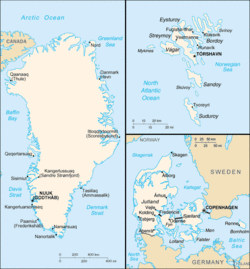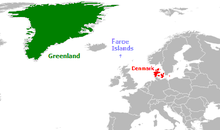Kingdom of Denmark
Kingdom of Denmark Kongeriget Danmark, Danmarks Rige | |
|---|---|
 Denmark, Greenland, and the Faroe Islands | |
| Capital and largest city | Copenhagen |
| Official languages | Danish, Faroese, Greenlandic |
| Government | Parliamentary democracy and Constitutional monarchy |
| Area | |
• Total | 2,220,093 km2 (857,183 sq mi) |
| Population | |
• 1 October 2008 estimate | 5,626,011 (108th) |
• Density | 2.5/km2 (6.5/sq mi) |
| Currency | Danish krone (DKK) |
| Drives on | right |
| Calling code | +45 (Denmark), +298 (Faroes), +299 (Greenland) |
| ISO 3166 code | DK |
The Kingdom of Denmark (Template:Lang-da, pronounced [ˈd̥ænmɑɡ̊] , (archaic:) [ˈd̥anmɑːɡ̊], or Danmarks Rige), or Danish Realm, is a constitutional monarchy and a community consisting of three autonomous parts: Denmark in northern Europe, the Faroe Islands in the North Atlantic, and Greenland in North America, with Denmark as the hegemonial part, where the residual judicial, executive and legislative power rests.[1] The relationship of the member states is referred to as Rigsfællesskabet.[2] According to the Faroese home rule act, the Faroe Islands constitutes a community of people within the kingdom.[note 1] The Greenlandic self-government act does not contain a similar definition but describes the Greenlandic people as a people as defined in international law with the right to self-determination.[note 2]
Of the three, only Denmark is a member of the European Union.
| Country | Population | Area (km²) | Density (Pop per km²) |
| 5,626,011 | 2,220,093 | 2.5 | |
| 5,519,441 | 43,094 | 127 | |
| 49,006 | 1,399 | 34 | |
| 57,564 | 2,175,600 | 0.026 |
Government and politics

The Folketing is the national legislature. Parliament consists of 175 members elected by proportional majority from Denmark, plus two members each elected from Greenland and the Faroe Islands. Parliamentary elections are held at least every four years, but it is within the powers of the Prime Minister to call one at his discretion before this period has elapsed.
Geography
Phytogeographically, Denmark, as well as Greenland and the Faroe Islands, belongs to the Boreal Kingdom and is shared between the Arctic, Atlantic European and Central European provinces of the Circumboreal Region. According to the WWF, the territory of Denmark can be subdivided into two ecoregions: the Atlantic mixed forests and Baltic mixed forests. The Faroe Islands are covered by the Faroe Islands boreal grasslands, while Greenland hosts the ecoregions of Kalaallit Nunaat high arctic tundra and Kalaallit Nunaat low arctic tundra.
History
During the 8th–11th centuries, the Norse discovered and settled Shetland, Orkney, the Faroe Islands, Iceland, Greenland and attempted to establish a settlement in Vínland, believed to be at L'Anse aux Meadows in Newfoundland. They also conquered and settled parts of England (the Danelaw), Ireland, and Normandy, and founded the Kievian Rus' in the east; what would eventually become the Tsardom of Russia. The Norse ran trade routes from Greenland in the north to Constantinople in the south via Russian rivers. Denmark-Norway was formed as a state in 1536, following a personal union of Denmark and Norway.
The Dano-Norwegian union was dissolved by the Treaty of Kiel in 1814, with Denmark keeping the Norwegian dependencies of Iceland, the Faroe Islands, and Greenland. Denmark also ruled over Danish India (Tranquebar) from 1620 to 1869, the Danish Gold Coast (Ghana) from 1658 to 1850, and the Danish West Indies (the U.S. Virgin Islands) from 1671 to 1917.
Iceland achieved home rule in 1874, and became a fully sovereign state in 1918, united with Denmark under a common king. The Icelanders abolished the monarchy in 1944, and in 1948 the Faroese gained home rule. The kingdom joined the European Economic Community (now the European Union) without the Faroes in 1973, and Greenland withdrew in 1985, in both cases because of fisheries policies. Greenland gained home rule in 1979 and a proposal for introducing further autonomy in 2009 was approved in a referendum in 2008. Greenlanders consider independence if enough natural resources are discovered to make that prospect economical.
Endnotes
- ^ The Faroese home rule §1: "The Faroe Islands constitute a self-governing community of a people within the Kingdom of Denmark within the framework of this law..."[3]
- ^ The Greenlandic self-government act: "In recognition of the fact that the people of Greenland constitutes a people in international law with the right to self-determination, the law builds on a wish to promote equality and mutual respect in the partnership between Denmark and Greenland."[4]
References
- ^ Harhoff, Frederik (1993) Rigsfællesskabet (in Danish with English summary). Århus: Klim, p. 498. ISBN 87-7724-335-8
- ^ Skou, Kaare R. (2005) Dansk politik A-Å (in Danish). Aschehoug, p. 578. ISBN 87-11-11652-8
- ^ Lov om Færøernes Hjemmestyre Template:Da icon. Retsinformation.dk. "§ 1. Færøerne udgør inden for denne Lovs Rammer et selvstyrende Folkesamfund i det danske Rige. I Henhold hertil overtager det færøske Folk ved sin folkevalgte Repræsentation, Lagtinget, og en af dette oprettet Forvaltning, Landsstyret, inden for Rigsenheden Ordningen og Styrelsen af færøske Særanliggender som angivet i denne Lov."
- ^ Lov om Grønlands Selvstyre Template:Da icon. Retsinformation.dk. "I erkendelse af, at det grønlandske folk er et folk i henhold til folkeretten med ret til selvbestemmelse, bygger loven på et ønske om at fremme ligeværdighed og gensidig respekt i partnerskabet mellem Danmark og Grønland.

